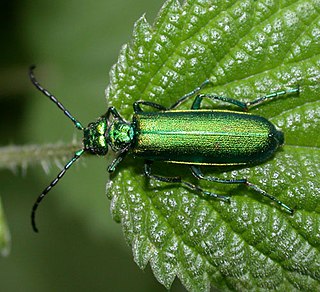
The Spanish fly is an aposematic emerald-green beetle in the blister beetle family (Meloidae). It is distributed across Eurasia.

Cantharidin is an odorless, colorless fatty substance of the terpenoid class, which is secreted by many species of blister beetles. It is a burn agent or a poison in large doses, but preparations containing it were historically used as aphrodisiacs. In its natural form, cantharidin is secreted by the male blister beetle, and given to the female as a copulatory gift during mating. Afterwards, the female beetle covers her eggs with it as a defense against predators.

Blister beetles are beetles of the family Meloidae, so called for their defensive secretion of a blistering agent, cantharidin. About 7,500 species are known worldwide. Many are conspicuous and some are aposematically colored, announcing their toxicity to would-be predators.

The golden poison frog, also known as the golden dart frog or golden poison arrow frog, is a poison dart frog endemic to the rainforests of Colombia. The golden poison frog has become endangered due to habitat destruction within its naturally limited range. Despite its small size, this frog is considered to be the most poisonous extant animal species on the planet.

Meloe is a genus of blister beetles commonly referred to as oil beetles. The name derives from their defensive strategy: when threatened by collectors or predators they release oily droplets of hemolymph from their joints. This fluid is bright orange and contains cantharidin, a poisonous chemical compound. Wiping the chemical on skin can cause blistering and painful swelling of the skin. This defensive strategy is not exclusive to this genus; all meloids possess and exude cantharidin upon threat.
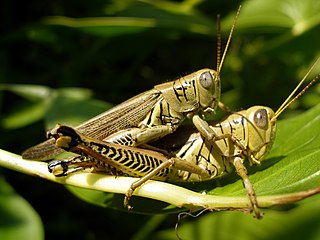
The differential grasshopper is a species of grasshopper belonging to the genus Melanoplus. It is found throughout northern Mexico, the central United States and southern Ontario, Canada. It is considered a pest over most of its range.

Diamphidia, or Bushman arrow-poison beetle, is an African genus of flea beetles, in the family Chrysomelidae.

Melanoplus bivittatus, the two-striped grasshopper, is a poikilothermic species of grasshopper belonging to the genus Melanoplus. It is commonly found in North America, with high quantities inhabiting Canadian prairies and farmland.
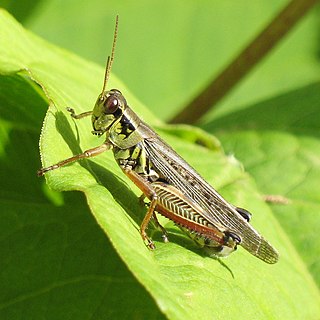
Melanoplus femurrubrum, the red-legged grasshopper, is a species of grasshopper belonging to the genus Melanoplus. It is one of the most common grasshoppers found in Mexico, the United States, and Canada. This grasshopper is frequently used as a model organism in scientific studies, due to their abundance throughout North America and behavioral response to changes in climate.

Epicauta is a genus of beetles in the blister beetle family, Meloidae. The genus was first scientifically described in 1834 by Pierre François Marie Auguste Dejean. Epicauta is distributed nearly worldwide, with species native to all continents except Australia and Antarctica. Surveys have found the genus to be particularly diverse in northern Arizona in the United States. Few species occur in the Arctic, with none farther north than the southern Northwest Territory of Canada.

Lytta nuttalli, or Nuttall's blister beetle, is a species of North American beetle first described in 1824 by Thomas_Say. The genus Lytta is from a Latin word suggesting madness The specific nuttallii recognizes the contributions of Thomas Nuttall, a contemporary of Say.

Mermis nigrescens is a species of nematode known commonly as the grasshopper nematode. It is distributed in the Americas, Europe, and Asia. It occurs in Tasmania, but it has not been observed on mainland Australia. It has been rarely observed in Africa. It is a parasite of insects, especially grasshoppers.
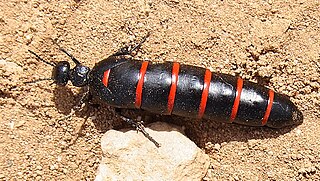
Berberomeloe majalis, the red-striped oil beetle, is an insect in the genus Berberomeloe, in the family of Blister Beetles. It is native to the western Mediterranean Basin.
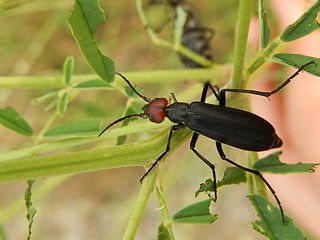
Epicauta rufidorsum is a species of beetle of the family Meloidae.

Ceroctis capensis, or spotted blister beetle, is diurnal and endemic to Southern Africa occurring in diverse habitats, and belonging to the Meloidae or Blister beetle family. It secretes a toxic liquid from its leg joints when roughly handled, blistering human skin. This species somewhat resembles Mylabris oculata, a member of the same family.

Stenoria analis, the ivy bee blister beetle, is a species of blister beetle from the family Meloidae which is found in western Europe and North Africa and is a specialist cleptoparasite of the ivy bee larvae. Its occurrence in regions outside of the known range of the ivy bee, for example in North Africa, suggest that it has other hosts.
Tegrodera aloga, the iron cross blister beetle, is a species of blister beetle in the family Meloidae. It is found in Arizona, California, and Sonora.

Megetra vittata is a species of blister beetle in the family Meloidae. It is found in North America. Like other blister beetles, megetra vittata excrete cantharidin, a toxic chemical, to defend itself from predators. Animals such as horses can fall ill and die from this toxin as a result of eating many of these beetles, as they have been reported to get mixed in with their hay and other feed.

Physomeloe corallifer is a species of blister beetle native to the Iberian Peninsula, it is the only recognised species in the genus Physomeloe.


















